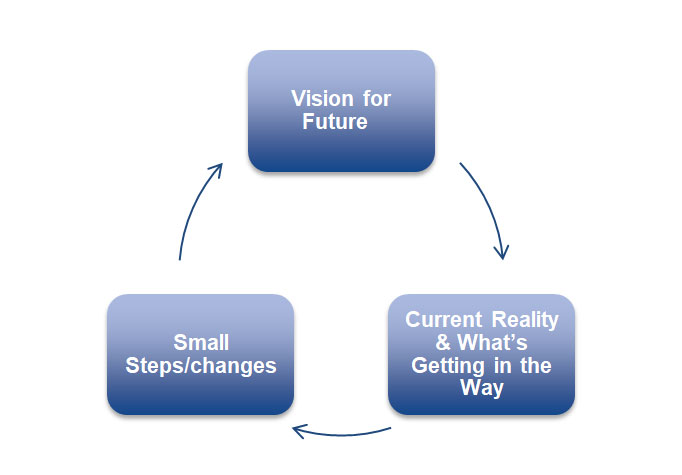
Here’s the paradox. Organizations don’t change without people in that organization changing. And, yet, individuals changing in an organization rarely, ok, never translates into long-lasting organization-wide change. While individual change and growth are necessary requirements for organizational change, on its’ own, individual development efforts are insufficient. Why? Individual changes are almost impossible to maintain when the system in which you operate doesn’t change. Remember that organizations are complex, living systems, and like all systems, are built to maintain equilibrium or homeostasis e.g. status quo. Meaning that there are many factors in your organization that are influencing the results you are currently getting and helping to ensure that you continue to get those same results. Factors like how your organization is structured, where decision authorities lie, your key business processes and how you recognize and reward behaviour. One individual who has made efforts to grow and operate differently still needs to operate within a context and system and with people who haven’t changed. More often than not the fight for equilibrium wins out and the individual reverts back to old behaviour, or decides to leave.
What dramatically increases your chances of actually affecting change? Working with teams. In the last several years, I’ve gravitated more and more to working with teams, utilizing a team coaching approach, as my preferred way to helping organizations and leaders achieve the changes they want in their companies. Something magical happens when you work with teams. They create a bond and commitment to each other, along with a fierce, passionate focus on bringing about the future they envisioned, and that, in turn creates a powerful ripple effect in the organization that disrupts the forces of homeostasis, allowing for change to take place. So, what is team coaching and what does it typically involve? Here’s what I’ve learned.
What is team coaching? A wildly effective process for communicating, that stimulates performance & change.
Here’s a definition of coaching that I really like penned by Melinda Sinclair and Dorothy Greenaway in their book The Leadership Coach’s Advantage. “Coaching is focused conversations with the purpose of facilitating performance, learning and change with a leader/team, relevant to their organizational and business context.” My role as a team coach is to incite and provoke those structured conversations with the team as a whole, and with individuals on the team, that enable performance, learning and growth.
What does it involve? Two distinct phases. Phase one is discovery.
I use a simple change model to guide my conversations with the team in phase one of our journey, which typically takes place over a three-month time frame. Here it is:

Step 1: Defining the future.
As a team, this is the first place we dive into when we begin working together. What are your goals? What is your future vision for this team/department/function? What makes it so compelling and important? As a team, we spend time dreaming together and in deep conversation so that each team member shares a common understanding and language about the vision. We then talk about how the team wants to operate with each other. We define what great team work is going to look like and we make specific commitments around the kind of behaviour each member will commit in order to do great work together.
Step 2: Assessing the team’s current reality.
Where is the team right now? What strengths do you have? What gaps and weaknesses do you have? What’s the context in which you are currently operating? What obstacles do you face? What in your system (think structure, processes, rewards, people – skills & mindsets) might get in the way of achieving your future vision? A key component of this stage is gathering feedback from key stakeholders, both at the individual level and the team level. I often use a leadership 360° tool to get feedback for each individual team member and a picture of the team’s strengths and weaknesses. In addition, I often conduct interviews with key stakeholders (customers, cross-functional partners, direct and indirect reports, executive leaders) so that the team understands their current reality from multiple perspectives.
Step 3 : brainstorm
After determining where the team is headed and understanding their strengths and the gaps between where they are now and where they want to be, we then brainstorm the actions that the team can make in order to move toward their vision. At the same time, each team member chooses development actions they will personally take, given their feedback and in the context of their role, in order to advance towards the team’s vision.
Defining the future is easy. Facing your current reality is tough, but necessary.
Here’s what most of us do. We spend time defining the future. That’s the fun stuff, isn’t it? Then, we enthusiastically jump from defining our future vision to action planning - determining the precise actions and roadmap that will lead us toward our future. What we fail to do to is to assess our current reality. We don’t seek out feedback on our strengths and our weaknesses. We don’t pause to consider what is working and not working in how we currently operate. Instead, we jump blindly to defining actions before we know what we have. Why do we this? A few reasons I’m sure. One is that we far underestimate what it takes to bring about change in an organization. Second, it’s hard and uncomfortable to look in the mirror and really see ourselves. And we aren’t really built to do so. Remember, humans are story-telling creatures. Our brains are wired to create narratives and patterns. We get pretty caught up in the narratives we spin about ourselves, as individuals, teams and as an organization. We create these narratives based on our intentions and our dreams of who we want to be. We need to disrupt ourselves so that we can accurately assess where we are. While I can guarantee that we’ll experience pain in facing our current reality, I’ve learned that it is an essential part of the process in order to move us forward quickly to create enduring and wide-spread changes.
Phase two of the journey is execution & learning
The second part of the team journey is where the team works against their action plans. My role as team coach during this phase is to provoke learning and performance. I do that by pausing the team periodically to reflect on the action they’ve taken, asses what is working and what isn’t, derive insight and learning that they can apply to new scenarios, and course correct so they are ready to act again. This is an exciting part of the journey, as the team gets more and more effective working together and you can see momentum being built and witness the changes taking place. This phase usually takes between three to five months for the team to really hit their stride.
Note: This process isn’t linear or standardized.
I know that what I’ve just outlined sounds like a linear and somewhat “cookie cutter” approach to team coaching. Trust me, it isn’t. While I’m guided by a few processes and concepts, my work is to apply all my skills, experience and energy to co-create with each team a highly customized, intimate experience, that meets the team exactly where they are and guides them to where they want to go, in the context of their business and cultural reality. Hence the reason I love this work. It’s never, ever the same.
Margaret Mead’s famous quote acts as a north star for me, especially working with teams. “Never doubt that a small group of thoughtful, committed citizens can change the world; indeed it is the only thing that ever has.”I couldn’t agree more.
